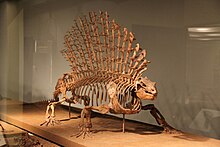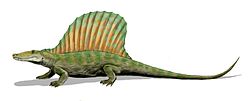Edaphosauridae
| Edaphosauridae Temporal range: Late Carboniferous to Early Permian, ~ | |
|---|---|
 | |
| Mounted skeleton of Edaphosaurus pogonias in the Field Museum of Natural History | |
| Scientific classification | |
| Domain: | Eukaryota |
| Kingdom: | Animalia |
| Phylum: | Chordata |
| Clade: | Synapsida |
| Clade: | Sphenacomorpha |
| Family: | †Edaphosauridae Cope, 1882 |
| Type species | |
| †Edaphosaurus pogonias Cope, 1882 | |
| Genera | |
Edaphosauridae is a family of mostly large (up to 3 m (9.8 ft) or more) Late Carboniferous to Early Permian synapsids. Edaphosaur fossils are so far known only from North America and Europe.
Characteristics
[edit]They were the earliest known herbivorous amniotes and, along with the Diadectidae, the earliest known herbivorous tetrapods.[3] The head is small in relation to the bulky body, and there is a tall sail along the back, which may have functioned as a thermoregulatory device.
Classification
[edit]The interrelationships of Edaphosauridae was investigated in details by David M. Mazierski and Robert R. Reisz (2010). The cladogram below is modified after their phylogenetic analysis.[4]
| Edaphosauridae | |
Below is a cladogram modified from the analysis of Benson (2012):[5]
References
[edit]- ^ Mann, A.; Henrici, A. C.; Sues, H.-D.; Pierce, S. E. (2023). "A new Carboniferous edaphosaurid and the origin of herbivory in mammal forerunners". Scientific Reports. 13 (1): 4459. Bibcode:2023NatSR..13.4459M. doi:10.1038/s41598-023-30626-8. PMC 10076360. PMID 37019927.
- ^ Frederik Spindler, Sebastian Voigt & Jan Fischer (2019) Edaphosauridae (Synapsida, Eupelycosauria) from Europe and their relationship to North American representatives. PalZ (advance online publication) DOI: https://doi.org/10.1007/s12542-019-00453-2 https://link.springer.com/article/10.1007/s12542-019-00453-2
- ^ A new Carboniferous edaphosaurid and the origin of herbivory in mammal forerunners
- ^ David M. Mazierski and Robert R. Reisz (2010). "Description of a new specimen of Ianthasaurus hardestiorum (Eupelycosauria: Edaphosauridae) and a re-evaluation of edaphosaurid phylogeny". Journal of Vertebrate Paleontology. 47 (6): 901–912. Bibcode:2010CaJES..47..901M. doi:10.1139/E10-017.
- ^ Benson, R.J. (2012). "Interrelationships of basal synapsids: cranial and postcranial morphological partitions suggest different topologies". Journal of Systematic Palaeontology. 10 (4): 601–624. Bibcode:2012JSPal..10..601B. doi:10.1080/14772019.2011.631042. S2CID 84706899.
- Carroll, R. L. (1988), Vertebrate Paleontology and Evolution, WH Freeman & Co.
- Reisz, R. R., 1986, Handbuch der Paläoherpetologie – Encyclopedia of Paleoherpetology, Part 17A Pelycosauria Verlag Dr. Friedrich Pfeil, ISBN 3-89937-032-5
External links
[edit]


 French
French Deutsch
Deutsch




